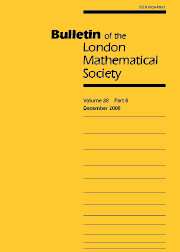Crossref Citations
This article has been cited by the following publications. This list is generated based on data provided by Crossref.
Braden, H. W.
1998.
The Equations ATX\pm XTA=B.
SIAM Journal on Matrix Analysis and Applications,
Vol. 20,
Issue. 2,
p.
295.
Dittmann, J
1999.
Explicit formulae for the Bures metric.
Journal of Physics A: Mathematical and General,
Vol. 32,
Issue. 14,
p.
2663.
Dittmann, J.
1999.
The scalar curvature of the Bures metric on the space of density matrices.
Journal of Geometry and Physics,
Vol. 31,
Issue. 1,
p.
16.
Dittmann, J.
and
Uhlmann, A.
1999.
Connections and metrics respecting purification of quantum states.
Journal of Mathematical Physics,
Vol. 40,
Issue. 7,
p.
3246.
Shapiro, Helene
1999.
The Weyr Characteristic.
The American Mathematical Monthly,
Vol. 106,
Issue. 10,
p.
919.
Faβbender, Heike
Mackey, D. Steven
Mackey, Niloufer
and
Xu, Hongguo
1999.
Hamiltonian square roots of skew-Hamiltonian matrices.
Linear Algebra and its Applications,
Vol. 287,
Issue. 1-3,
p.
125.
Li, Ren-Cang
2000.
A Bound on the Solution to a Structured Sylvester Equation with an Application to Relative Perturbation Theory.
SIAM Journal on Matrix Analysis and Applications,
Vol. 21,
Issue. 2,
p.
440.
Duggal, B.P.
2000.
Range kernel orthogonality of derivations.
Linear Algebra and its Applications,
Vol. 304,
Issue. 1-3,
p.
103.
Torki, Mounir
2001.
Etude de la Sensibilité de Toutes les Valeurs Propres non Nulles d'un Opérateur Compact Autoadjoint.
Mathematische Nachrichten,
Vol. 223,
Issue. 1,
p.
135.
Corach, Gustavo
and
Maestripieri, Alejandra L.
2001.
Geometry of positive operators and uhlmann's approach to the geometric phase.
Reports on Mathematical Physics,
Vol. 47,
Issue. 2,
p.
287.
DUCLOS, P.
LEV, O.
ŠŤOVÍČEK, P.
and
VITTOT, M.
2002.
WEAKLY REGULAR FLOQUET HAMILTONIANS WITH PURE POINT SPECTRUM.
Reviews in Mathematical Physics,
Vol. 14,
Issue. 06,
p.
531.
Avrachenkov, K.E.
and
Lasserre, J.B.
2002.
Analytic perturbation of Sylvester matrix equations.
IEEE Transactions on Automatic Control,
Vol. 47,
Issue. 7,
p.
1116.
Bhatia, Rajendra
and
Elsner, Ludwig
2002.
Linear Operators and Matrices.
p.
107.
Huang, Sen-Zhong
2003.
An operator method for finding exact solutions to vector Korteweg–de Vries equations.
Journal of Mathematical Physics,
Vol. 44,
Issue. 3,
p.
1357.
Williams, Alan
Leen, Todd K.
and
Roberts, Patrick D.
2004.
Random walks for spike-timing-dependent plasticity.
Physical Review E,
Vol. 70,
Issue. 2,
Immonen, Eero
2005.
Function generators, the operator equation ΠS=AΠ+BQ and inherited dynamics in inhomogenous Cauchy problems.
Journal of Differential Equations,
Vol. 218,
Issue. 2,
p.
253.
Bean, Nigel G.
O'Reilly, Małgorzata M.
and
Taylor, Peter G.
2005.
ALGORITHMS FOR RETURN PROBABILITIES FOR STOCHASTIC FLUID FLOWS.
Stochastic Models,
Vol. 21,
Issue. 1,
p.
149.
Bean, Nigel G.
O’Reilly, Małgorzata M.
and
Taylor, Peter G.
2005.
Hitting probabilities and hitting times for stochastic fluid flows.
Stochastic Processes and their Applications,
Vol. 115,
Issue. 9,
p.
1530.
Bentosela, F.
Duclos, P.
Moldoveanu, V.
and
Nenciu, G.
2005.
The dynamics of one-dimensional Bloch electrons in constant electric fields.
Journal of Mathematical Physics,
Vol. 46,
Issue. 4,
Baskakov, A. G.
2006.
Representation theory for Banach algebras, Abelian groups, and semigroups in the spectral analysis of linear operators.
Journal of Mathematical Sciences,
Vol. 137,
Issue. 4,
p.
4885.


